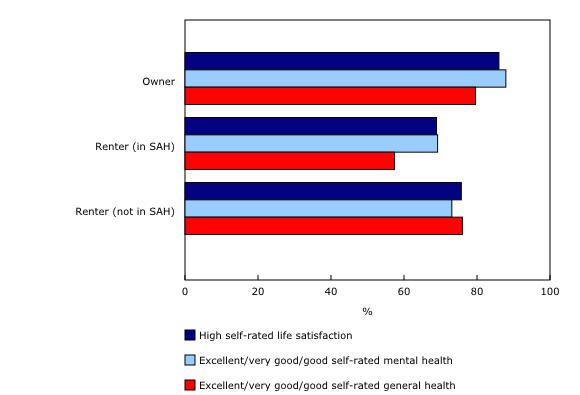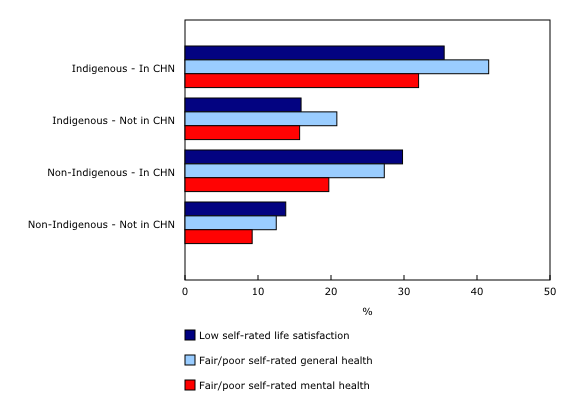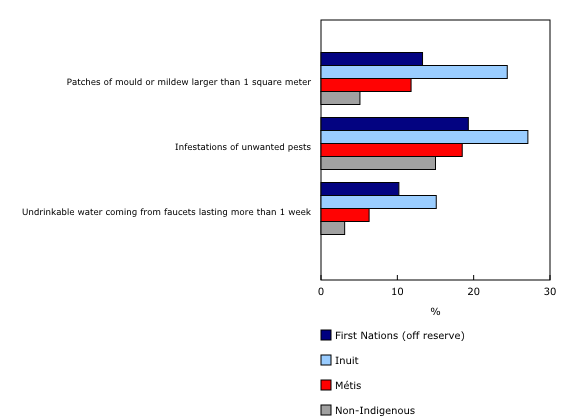Study: Housing experiences and well-being among First Nations people living off reserve, Métis and Inuit, 2018
Released: 2023-04-04
As a key social determinant of health, housing tenure and conditions can have profound impacts on well-being. Indigenous people are disproportionately affected by inadequate, unaffordable, and unsuitable housing as findings from a newly released study on housing experiences and well-being indicate.
Using the 2018 Canadian Housing Survey, a unique dataset that combines housing and well-being indicators, this study examines previously explored housing measures (e.g., living in crowded dwellings or those in need of major repairs) in addition to new ones in relation to health, life satisfaction, and financial hardship offering a more fulsome picture of housing and well-being among Indigenous people. Given the nature of the survey's data collection, the findings of this study are reflective of responses obtained from Indigenous housing decision-makers aged 15 and older (known as reference persons) within their household with estimates presented for Indigenous households and people within those households where relevant. Findings exclude people living on reserve.
Close to 1 in 4 Indigenous households lived in rented social and affordable housing in 2018
Looking at housing tenure, Indigenous households were less likely to own their dwelling than non-Indigenous households (63.9% vs. 68.7%) in 2018. Over one-third of Indigenous households (36.1%) lived in rented dwellings and close to 1 in 4 of these renter households (23.8%) lived in social and affordable housing which is nearly double that of non-Indigenous households (13.0%).
The proportion of lone-parent households was greater among Indigenous compared with non-Indigenous renter households (17.7% vs. 9.6%), especially among those living in social and affordable housing. Of the 54,450 Indigenous renter households in social and affordable housing in 2018, close to one-quarter (24.3%) were lone-parent households compared with 17.7% of non-Indigenous households in social and affordable housing. Both Indigenous and non-Indigenous lone-parent households were more likely to be female-led than male-led across housing tenures.
Dwelling satisfaction lower and financial hardship higher among Indigenous renter versus Indigenous owner households
Among Indigenous owner-households, 85.3% reported they were very satisfied or satisfied with their dwelling in 2018, while this was lower among Indigenous renter households (72.0%) and more so among those in social and affordable housing (68.9%). Past-year levels of financial hardship were higher among Indigenous renter households (41.6%) and especially those living in social and affordable housing (55.8%) when compared with Indigenous owner households (28.0%). Non-Indigenous households, irrespective of housing tenure, followed a similar pattern across measures of dwelling satisfaction and financial hardship.
Higher life satisfaction and better health were reported by Indigenous reference persons in owner households
In 2018, 86.0% of Indigenous reference persons in owner households reported high life satisfaction, compared with 74.0% in renter households and 68.9% in social and affordable housing. Roughly 9 in 10 Indigenous reference persons who lived in owned dwellings reported excellent, very good, or good mental health and general health, with corresponding percentages lower among those living in rented dwellings (72.1% for mental health and 71.2% for general health) and social and affordable housing (69.2% and 57.4%).
Similar differences by housing tenure were seen among non-Indigenous reference persons across measures of health and well-being.
Over one-third of Inuit were in core housing need in 2018
Core housing need is a measure designed to identify dwellings that are unsuitable (size of the household exceeds the number of bedrooms required), inadequate (dwelling in need of major repairs) and unaffordable (spending 30% or more of income on shelter cost). In 2018, over one-third of Inuit (35.3%) and over 1 in 10 First Nations people living off reserve (12.0%) and Métis (12.6%) were in core housing need.
Close to one-third of Inuit (30.0%) reported living in inadequate housing in 2018, while 13.8% of First Nations people living off reserve and 11.5% of Métis reported the same. Just over 4 in 10 (42.7%) Inuit reported living in an unsuitable dwelling, whereas the proportions were lower among First Nations people living off reserve (15.6%) and Métis (8.1%). When it comes to unaffordable housing, just under 1 in 5 Métis (18.2%), 1 in 6 First Nations people living off reserve (16.6%), and just over 1 in 20 Inuit (5.5%) lived in unaffordable housing. This latter finding might reflect specific housing access and cost issues unique to the regions that comprise Inuit Nunangat, where most Inuit live, including a higher percentage of subsidized dwellings that are in poor condition.
Over half of First Nations people living off reserve and three-fifths of Inuit and Métis in core housing need reported it was very difficult or difficult to meet past-year financial needs
In 2018, around 4 in 10 Inuit and Métis and 3 in 10 First Nations people living off reserve experienced financial difficulties in terms of transportation, housing, food, clothing, and other necessary expenses in the 12 months preceding the survey.
Among Indigenous people in core housing need, over half of First Nations people living off reserve (52.3%) and just over three-fifths of Inuit (69.1%) and Métis (65.7%), reported that it was very difficult or difficult to meet past-year financial needs. In contrast, under one-half (45.2%) of non-Indigenous people in core housing need reported the same.
First Nations and Métis reference persons in core housing need were about twice as likely as those who were not to report poorer mental health and lower life satisfaction
Compared with those who were not in core housing need in 2018, Indigenous reference persons in core housing need were more likely to report fair or poor general health (41.6% of those in core housing need vs. 20.8% of those not in core housing need), fair or poor mental health (32.0% vs. 15.7%) as well as low ratings of life satisfaction (35.5% vs. 15.9%). While a similar pattern was seen among non-Indigenous people by core housing need, the proportions reporting poorer health and lower life satisfaction were lower than those seen among their Indigenous counterparts.
Among Indigenous reference persons in core housing need in 2018, just under two-fifths of First Nations people living off reserve reported fair or poor general health (39.8%) and mental health (34.6%). Among Métis reference persons in core housing need, just under one-half (47.0%) reported fair or poor general health, while around one-third (32.6%) reported fair or poor mental health. Roughly 1 in 5 Inuit reference persons (19.4%) in core housing need reported fair or poor general health and 12.4% reported fair or poor mental health.
Indigenous people more likely to report dwelling issues and dissatisfaction with their dwelling's wheelchair accessibility and energy efficiency
Compared with their non-Indigenous counterparts, Indigenous people were nearly three times more likely to report undrinkable water coming from faucets lasting more than a week (8.7% for Indigenous people vs. 3.1% for non-Indigenous people) and having patches of mould and mildew larger than one square meter (13.2% vs. 5.1%). Infestations of unwanted pests were the most frequently reported dwelling issue, with roughly 1 in 5 First Nations people living off reserve (19.3%) and Métis (18.5%) reporting this, along with over one-quarter of Inuit (27.1%).
When asked to report the level of satisfaction with dwelling conditions, Indigenous people were most frequently dissatisfied with wheelchair accessibility (42.5%), energy efficiency (22.2%) and the ability to maintain a comfortable temperature in both summer (20.1%) and winter (17.7%).
Note to readers
One questionnaire is completed per dwelling by the reference person in the household. The reference person is the household member responsible for housing decisions. When household members share responsibility for housing decisions, one person is chosen as the reference person.
To account for specific housing measures among Indigenous and non-Indigenous households, Indigenous households are defined by Canada Mortgage and Housing Corporation as a non-family household in which at least 50% of household members self-identified as Indigenous (single identity); or a family household that meets at least one of two criteria: at least one spouse, common-law partner, or lone parent self-identified as Indigenous; or at least 50% of household members self-identified as Indigenous.
Social and affordable housing refers to 'non-market rental housing', where housing allocation and rent-setting mechanisms are not entirely dictated by the law of supply and demand. Social housing is government-assisted housing that provides lower cost rental units to households with low-to-moderate incomes.
Products
The study "Housing experiences and measures of health and well-being among First Nations people living off reserve, Métis and Inuit: Findings from the 2018 Canadian Housing Survey" is now available as part of the Indigenous Peoples Thematic Series (41200002).
Contact information
For more information, or to enquire about the concepts, methods or data quality of this release, contact us (toll-free 1-800-263-1136; 514-283-8300; infostats@statcan.gc.ca) or Media Relations (statcan.mediahotline-ligneinfomedias.statcan@statcan.gc.ca).
- Date modified:



